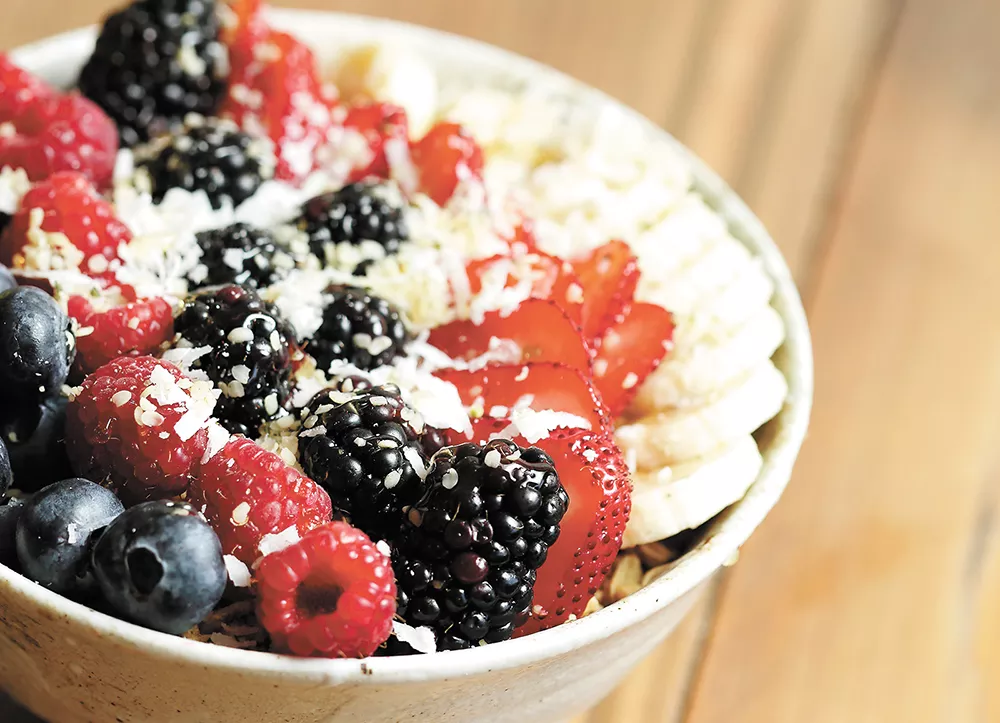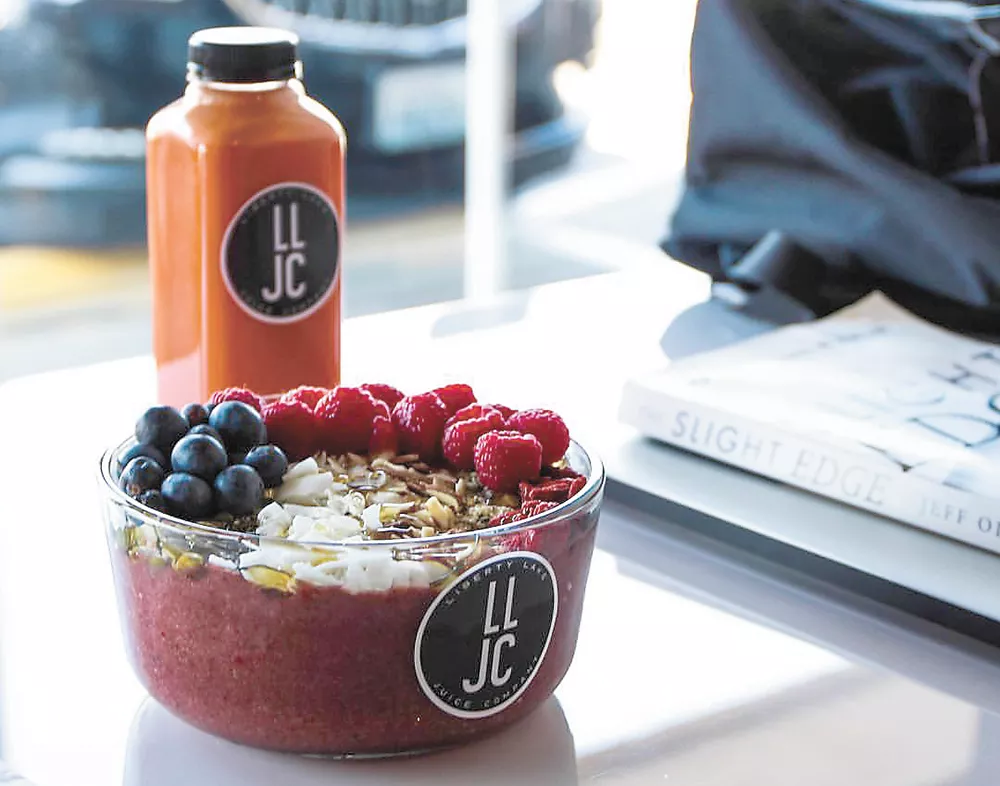
With their pleasing deep-violet hue, chilly temperature and nearly limitless topping choices, açaí bowls are one of the latest hot trends to hit the menus of juice, smoothie and other health-centric cafés around the U.S. in the past decade.
Touted for having numerous good-for-you attributes, açaí (pronounced "ah-SIGH-ee") bowls are antioxidant- and fiber-rich, made from all-natural and whole-food ingredients — mainly fruits, veggies, nuts and grains; they're also colorful, refreshing and often filling.
These bright and bountiful bowls are served at several locations across the Inland Northwest, including the Wellness Bar's three North Idaho locations, in Coeur d'Alene, Hayden and Post Falls.
With a mix of sweet, tart, chocolatey and earthy flavor traits, the açaí berry, a fruit native to South America, can be paired with everything from kale to peanut butter, bananas to avocados, other berries and beyond. They're as versatile, if not more so, as their blended smoothie counterparts consumed via straw, but with much more texture, thanks to the addition of toppings like granola, nuts, sliced fruit and seeds atop the frozen and blended açaí base.
Wellness Bar owners Tait and Monica Engebretsen, who discovered açaí smoothie bowls while traveling in Hawaii, have been serving them since at their juice bars for about two and a half years.
"We went to Maui and went to a couple juice bars, and they were selling açaí bowls, so we went and learned all the benefits, and we brought it back to Coeur d'Alene and were the first [here] to sell them," Monica Engebretsen says.
"They've changed the entire juice bar — people are loving them," she adds. "Our favorite thing is seeing the younger generation, from middle school to high school to college students, choosing to come here as opposed to fast food."
Açaí bowls like those at the Wellness Bar are made starting with frozen açaí purée. The berries come from the açaí palm native to the Amazonian floodplains and swamps of Brazil and northern South America. The açaí's seeds, which make up the bulk of the grape-sized berry's bulk, are removed after harvest; the remaining pulp is crushed into a deep red-purple mixture that's then frozen into little portion-sized packets to distribute to businesses like the Wellness Bar. (Other processes are used to freeze-dry the berry into a powdered form, though most juice bars prefer the frozen purée.)
Across Brazil, açaí bowls — açaí na tigela in Portuguese, which translates to "açaí in the bowl" — are a popular dish served in both sweet and salty versions, the latter of which contains shrimp or dried fish and tapioca.
You won't find this salty, fishy variant locally, though. At Wellness Bar, the most popular açaí blend is the "Bomb.com" ($9), which features a smoothie base of frozen açaí purée blended with cacao and topped with granola, almond butter, coconut flakes, almond slivers, sliced banana, berries, hemp hearts and honey.
Other versions of Wellness Bar's açaí bowls come topped with sweet berries and tart kiwi, peanut butter and dark chocolate, or lots of plant seeds, like pumpkin, sunflower and chia. Its three juice bar locations also offer açaí-based smoothies ($8-$12), if you'd rather not eat the quickly melting mixture with a spoon.
In Spokane, açaí bowls are also a popular item on the menu at Method Juice Cafe's downtown and Northside locations, where customers can chose from several base blend and topping combos ($9/each). A long list of extra toppings ($.50-$3/each) can also be added to your bowl. And in the South Perry District, the Wellness Tree juice bar also offers a variety of tropical, nutty and berry-themed bowls, which come in small and regular sizes ($6/$9). Açaí is also on the menu at the new Liberty Lake Juice Co., and the daytime menu at Remedy on Spokane's South Hill.
All of these local spots also serve up the açaí berry's oft-blended counterpart, the pitaya, or "dragon fruit," in the same smoothie-bowl format. The startlingly neon-pink-colored pitaya, tarter than the earthier, chocolatey açaí, comes from the fruit of a cactus native to Mexico, Central and South America.
Whether you love açaí smoothie bowls for their nutty-meets-sweet-tart flavor or the inclusion of whole fruits, veggies, nuts and other plant-based ingredients — or maybe you're unaware of the trend — it can be hard to sort out the wide range of claims that have surrounded the berry and its purported benefits over the past decade (including massive scams that sold açaí supplements as a weight-loss and disease-curing miracle product touted by celebrities).
While açaí isn't actually a weight-loss miracle berry, eating fresh whole fruits and vegetables, whether in a salad, blended in a smoothie, in and atop an açaí bowl, is a great way to add those needed nutrients and fiber to your diet, explains Spokane registered dietitian and nutritionist Korrin Fotheringham.
The key to açaí, she says, is balance.
"As with anything, if you're going to replace foods you were previously eating with more fruits and veggies, that adds nutrients; whole foods, grains and other things that are really beneficial to our bodies," she says.
"You always have to compare it to what would have been eaten otherwise; if it's in addition to, or as a snack you wouldn't normally eat, it's not going to lead to weight loss," Fotheringham continues.
Often referred to as a "superfood," açaí berries contain some level of cancer- and age-fighting antioxidants, like many of their dark-hued fruit counterparts, cranberries, pomegranate, red grapes and blueberries. But there's actually been little in the way of conclusive, scientific research on the açaí berry's benefits to our health, Fotheringham notes.
While açaí bowls have also been criticized for being high in sugar, this isn't necessarily bad, she explains, because that sugar is coming from the natural fruit source rather than added, processed sugar.
So if your açaí smoothie bowl is full of other berries and fruits, she suggests adding plenty of toppings containing protein and healthy fats, like nuts and seeds, flaked coconut or rolled oats (she cautions that some granola blends can have added sugars). Again, remember: it's about nutrient balance.
"When I think about trends that are incorporating more fruits and veggies into the diets of Americans, it's exciting — that's always a great thing," Fotheringham summarizes.
"It's something that can be fun, especially for kids, to eat something that is purple. My daughter's favorite color is purple, and she gets excited when we go out and have a smoothie bowl, but sometimes we go for froyo, and sometimes we go for ice cream. It can all be part of a well-rounded diet that is healthful and nutrient-dense." ♦

